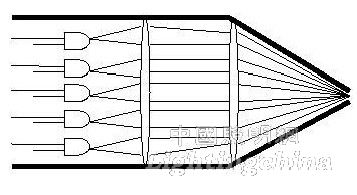0 Preface
Light emitting diode (LED) is a new type of solid-state light source competitive in the 21st century. It uses electrons and holes in a semiconductor material to combine and release energy, so that the energy band is changed in order to illuminate it. The energy released [1]. LED has the advantages of small size, long life, low driving voltage, low power consumption, fast switching speed, etc. It is widely used in signal indication, digital display, landscape lighting and other fields.
With the continuous advancement of technology, the successful development of high-brightness LEDs, especially white LEDs, has made it more and more used in many specific fields, such as painless acupuncture research in Chinese medicine. The author uses the LED array illuminating source to act on the acupuncture points of the human body to study the increase of the temperature of the skin surface, and then measure the impact on the human body. This painless acupuncture system can abolish the patient's concerns about traditional acupuncture pain and promote the development of Chinese medicine.
1 Features of high brightness LED
The LED light source is actually a P-N junction diode. It consists of a die-emitting semiconductor material and a wire holder. The periphery of the die is encapsulated by epoxy resin to protect the die. The optical path structure is shown in Figure 1 [2].

Figure 1 High-brightness LED optical path structure
1.1 Difference between high brightness LED and ordinary LED
LEDs can be used continuously for 100,000 hours, while incandescent lamps generally do not exceed 2000 hours, and fluorescent lamps do not exceed 5000 hours. LEDs are 1/4 more energy efficient than energy-saving lamps. Compared with the widely used second-generation fluorescent lamps, LEDs are mercury-free and stroboscopic, making them an environmentally friendly light source. The ambient temperature is between -40 and 80 °C, and the environmental adaptability is very strong.
Compared with ordinary LEDs, the most prominent feature of high-brightness LEDs is that the brightness is increased by nearly a hundred times. Ordinary LEDs have a luminous intensity of only a few ten to several tens of mCd, while high-intensity LEDs have a minimum luminous intensity of 1500 mCd. Another obvious difference is that the color of the light-emitting tube is different. Ordinary LEDs use a colored encapsulating material to obtain light of a certain color, that is, the encapsulating material functions as a color filter, and the high-brightness LED housing is a colorless transparent resin package, and the illuminating body itself can emit a certain color. A wavelength of light that appears to be a certain color.
1.2 Luminous flux of high brightness LED
Figure 2 is a plot of temperature versus luminous flux (φv) for an LED [3]. It can be seen from Fig. 2 that the luminous flux is inversely proportional to the temperature, the luminous flux at 85 ° C is 1/2 at 25 ° C, and the light output at -40 ° C is 1.8 times that at 25 ° C. The change in temperature also has a certain effect on the wavelength of the LED. Therefore, good heat dissipation is a guarantee that the LED maintains a constant brightness.

Figure 2 LED temperature and luminous flux curve (IF = 60mA)
2 LED operating characteristics analysis and its application
2.1 Principle of illumination
High-brightness LEDs refer to LEDs with a luminous efficacy of 100 lm/W or higher [4]. The applied voltage of the LED will generate stimulated electron transition light radiation inside the LED. The wavelength of light produced is also different according to the physical properties of different semiconductor basic materials. The substantial structure of the LED is a P-N junction. When the semiconductor P-N is connected with a forward current, a minority carrier is injected. The luminescence recombination of the minority carrier is the working mechanism of the LED. The semiconductor P-N junction luminescence is essentially solid luminescence, and various solid luminescences are the result of electronic transitions in different energy states within the solid. The luminescence mechanism of semiconductor materials determines that a single LED chip cannot emit a continuous spectrum of white light, and white light must be synthesized in other ways. High-brightness white LEDs are typically coated with a fluorescent material on a blue-emitting InGaN substrate that emits yellow light when excited by blue light, and a mixture of blue and yellow light forms white light.
2.2 Working characteristics
Since LEDs are DC-powered devices, it is easy to make DC lamps, which are widely used in DC systems, such as solar lighting products. High-brightness white LEDs are used in solar lamps. The light direction of a single beam-type high-brightness LED tube is too strong, and the overall visual effect is poor. Therefore, the flat-type high-brightness LED or the flat-type and beam-light type should be preferred. Bright LEDs are used in combination to group together multiple LEDs and arrange them into a regular LED illumination source [5]. The high-brightness white LED illumination source must ensure a certain illumination intensity and high light efficiency. However, if the current increases, the luminous flux increases, but on the other hand, the increase of the current causes the heat loss of the light source. The increase usually leads to an increase in tube temperature, and the combined effect is that the light efficiency is reduced, so the intersection of luminous flux and light efficiency is taken as the optimum working point (generally 17.5 mA).
2.3 LED application in medicine
According to the characteristics of the high-brightness LED, a certain number of high-brightness LEDs are irradiated to the human skin for a long time, and the energy generated by the LEDs is concentrated on the surface of the skin, and the surface temperature of the skin is measured to be elevated. The study further found that the increase in skin surface temperature can affect the mechanism of human tissue, which can play a certain role in the treatment of certain diseases. In fact, LEDs have been widely used in biomedical research, such as the treatment of some skin diseases.
Japanese professor Aya Aya found that LED lights have a certain effect on nerve cells. Using LEDs to illuminate nerve cells can promote the growth and tandem direction of nerve cells, and it is expected to conduct animal experiments, hoping to break through the bottleneck of spinal cord injury treatment [6].
The system utilizes the characteristics of high-brightness LEDs, so that the high-brightness LEDs are arrayed according to certain rules, and a lens display is placed in front of the array to collect the light into a point light source, so that the light source illuminates the acupuncture points or skin of the human body to make a similar Chinese medicine acupuncture. The instrument is more convenient for treating certain diseases.
3 LED light source light path design
As an LED light source that illuminates human tissues and organs, it is necessary to concentrate the illumination light to a point so that the energy is completely concentrated. When the irradiance is a constant, the irradiation dose received by the sample can be accurately controlled by adjusting the irradiation time. Therefore, the output light of the light source system is as parallel light as possible, and the illuminance of the LED output light is improved by focusing through the lens array, and the optical path model is shown in FIG.

Figure 3 LED array illumination path model
For the lens, the LED is not a point source in a strict sense, and the emitted light also has a certain spectral width. However, from the practical application, this paper adopts a reasonable approximation to regard the LED as a point-like light source and passes the LED on the photometric guide rail. For the image distance of the smallest image formed on the screen by lenses of different curvatures, the Gaussian formula is used to obtain the empirical focal length of the array lens in the selected LED and the lens L1 in the figure, and the lens L2 is a lens with a known focal length. Thus, after the output light is concentrated, the illuminance of the light source is enhanced.
In use, the LED light source array is combined with the lens group, and then fixed with a glass tube with a bright tin foil on the outside, and the front end is a small aperture with a diameter of about 5 mm, so that the light source gathers into a point and directly illuminates the human body acupuncture point or skin. .
4 Conclusion
The high-brightness LED array is used to illuminate human skin or tissue, and the energy generated by it is concentrated into points, simulating the acupuncture technology of traditional Chinese medicine, reducing the pain and fear of traditional acupuncture. The research of LED array simulation acupuncture irradiation pen provides an important reference value for painless acupuncture technology.
Edit: Cedar
Remote Training Collar,Pet Trainer Dog Training Collar,Remote Control Dog Training Collar,Stimulation And Vibration Remote Training Collar
Elite-tek Electronics Ltd , https://www.aetertek.ca
